How I Built a Three-AI Newsletter System That Writes With Me, Not For Me
Learn why AI specialization beats AI generalization for authentic content creation
Welcome to TBB: Think, Build, Brand - a Write10x segment that dives into how modern, full-stack creators use AI to shape standout ideas, build systems that scale, and brand themselves.
It's a front-row seat to how the best creators in the space is implementing AI, for your inspiration and education.
For our first edition, we're going to hear from Joel Salinas of Leadership in Change. Joel is an AI implementation leader, and his main focus is helping guide leaders use AI practically in their various fields.
Sponsored by Trendhopper.ai
Want to make your content unpromptable—and your publishing stack just plain smarter?
Switch from WordPress. Trendhopper is an AI-powered blog hosting platform built for modern creators who want fewer tools and more traction.
Have you ever watched a basketball team where one player tries to handle every position?
The point guard attempts to play center. The center tries to run point. Everyone's doing everything, and the result is chaos, missed shots, frustrated fans, and a team that loses games they should have won.
For months, I was that exhausted player in my AI content creation. I'd open ChatGPT at 9 PM and ask it to brainstorm ideas, write outlines, draft articles, edit copy, create social posts, and generate visuals. One AI tool doing everything for my Leadership in Change newsletter, while I re-prompted the same requests over and over until midnight.
The stakes were real: generic content that sounded like everyone else, newsletters that took 8 hours to create, and worst of all, messages that felt like they came from a machine instead of a mission-driven leader trying to serve other leaders.
Then I figured out something that changed everything for me: AI specialization works better than AI generalization.
Instead of forcing one AI to play every position, I built a specialized AI team where…
Claude handles creative strategy and research
ChatGPT executes specific tasks like thumbnail generation
Perplexity handles my research
Each AI tool does what it excels at, and I orchestrate the process.
The result? My newsletter creation time dropped from 8 hours per week to 2 hours per week, AND most of that time is now devoted to tweaks and improvements in each piece that I did not have time for in the past.
In this post, I want to show you how you can do the same.
The Problem with AI Generalists
Most creators make the same mistake I did. They pick one AI and expect it to be a Swiss Army knife for every creative task.
The reality is that today, in 2025, different tools have different strengths and weaknesses. You would use your friend with a PHD in molecular research to code your app! Or have your coder friend do molecular research!
The truth is, you miss opportunities when different tools excel at different things. ChatGPT might be great for conversational content, but Claude excels at deep analysis and maintaining consistent voice, and Perplexity shines at research verification. So I set out to make the most of this!
When you try to make one tool do everything, you get mediocre results across the board instead of excellence where it matters most.
Building My AI Team: The Workflow That Changed Everything
After months of frustration, I stopped asking "How can I make this ChatGPT better?" and started asking "What does each AI do best?"
That question led me to build what I call my AI content team. Here's how it works:
Claude Projects: The Creative Director
Claude became my creative director and voice coach. I built a comprehensive Claude Project that includes:
My 7-page writing guide with specific voice instructions, steps for content creation, including back-and-forth questions for me, AND clear instructions on headline and subtitle generation
Examples of my best content for voice matching
My humanized content guidelines to avoid AI-sounding language
Step-by-step processes for different content types
My target audience personas and messaging frameworks
Why Claude excels here: It maintains context across long conversations, understands nuance in voice and tone, and can reference complex guidelines consistently. When I upload my writing guide, Claude doesn't just follow it, it internalizes it.
Real example: When I need to write about AI ethics for leaders, I tell Claude: "Create an outline for AI guardrails that speaks to small business and nonprofits who are curious but cautious about technology."
Following the guide, it doesn’t just give me generic bullet points, it actually proceeds to ask me 5 questions to get me to think MORE critically before an approach is decided on in collaboration. Curious about the outcome? Check out the AI Ethics DeepDive post here.
"The AI Specialization Rule: One tool, one job, one expert result."
Perplexity: The Research Specialist
Perplexity became my fact-checker and research partner. While Claude creates the creative strategy, Perplexity verifies every statistic, finds current data, and sources credible quotes.
Why Perplexity excels here: Real-time web access, citation accuracy, and the ability to cross-reference multiple sources quickly. When I need to verify that "73% of executives plan to increase AI investment in 2024," Perplexity finds the original source, confirms the methodology, and suggests related data points.
Real example: Claude might suggest writing about AI's impact on productivity. Perplexity then finds the latest McKinsey research, verifies the statistics, and provides properly cited sources that I can reference confidently.
This handoff between specialized tools creates something neither could achieve alone. I value credibility and trust, and want my stats to be reviewed.
ChatGPT: The Production Specialist
Finally, ChatGPT handles specific execution tasks, particularly visual content creation. After Claude creates the article and strategy and provides the prompt I need for the thumbnail, all with my brand guide, I take that refined prompt to ChatGPT for thumbnail generation.
Why ChatGPT excels here: Strong integration with DALL-E and excellent at following detailed visual briefs. When I need a thumbnail that matches my brand style, ChatGPT can interpret complex visual instructions and iterate quickly.
Real example: Claude helps me craft THIS article. As part of my process, it then offers a few visual thumbnail options and after some back and forth and my sign off, it generates a prompt for the thumbnail I choose.
I then take Claude's refined understanding and ask ChatGPT to generate it.
Why Your AI Team Gets Smarter Over Time
Here's what most creators miss: AI specialization requires practice, just like human specialization.
When I first started using Claude Projects, the outputs weren't immediately perfect. I had to refine my guide, add more voice examples, and adjust my instructions based on what worked and what didn't.
The same applies to Perplexity and ChatGPT. Each tool got better at serving my specific needs as I practiced using them for their strengths rather than trying to make them do everything.
This is crucial: As both you and the tools evolve, you need systems to know where to move. My 7-page Claude guide isn't static. I update it based on what works, what doesn't, and how my voice develops. The AI team concept lets me optimize each tool independently instead of starting from scratch with one overwhelmed AI.
This eliminated the re-prompting cycle that used to waste hours of my week.
How My AI Team "Knows" Me
The magic happens because each AI specializes in knowing different aspects of my work:
Claude knows my voice through detailed examples and guidelines. It understands how I structure arguments, my preference for storytelling, and my mission-driven perspective.
Perplexity knows my research standards through consistent interaction patterns. It learns what sources I trust, what depth of verification I need, and what topics require extra scrutiny.
ChatGPT knows my visual brand through repeated thumbnail creation and specific style instructions. It understands my color palette, composition preferences, and the emotional tone I want to convey.
None of them tries to be everything to me. Each excels in its specialized role.
Finding Your Own AI Specialization
The biggest question I get after sharing this approach is: "Joel, this sounds great, but how do I know which AI tool to use for which task?"
That's exactly why I built the AI Task-Tool Matcher.
Access the AI Task-Tool Matcher
Based on months of testing different AI combinations for my newsletter and client work, I created an interactive tool that applies the AI Specialization Rule to your specific situation. It walks you through a guided assessment of your task, industry, audience, and complexity needs, then provides personalized tool recommendations with detailed reasoning.
Here's how it works:
Step 1: Choose your task type (writing, research, visual content, video, strategy, or analysis)
Step 2: Specify your industry, target audience, and complexity level
Step 3: Get matched with primary and backup AI tool recommendations
Step 4: Access optimized prompt templates for each recommended tool
The tool covers everything from Claude Projects for content creation to Perplexity for research verification to ChatGPT for visual generation. Each recommendation includes pricing information, key strengths, user counts, and specific reasoning based on the AI Specialization Rule.
What makes it different: Instead of generic "best AI tools" lists, it provides personalized matches based on your actual workflow needs. It explains not just which tool to use, but why that tool excels for your specific situation.
The tool draws from my research testing Claude, ChatGPT, Perplexity, Runway, Midjourney, and other platforms across different use cases. It's designed to help you stop the guesswork and start building your own specialized AI team with confidence.
Premium Leadership in Change subscribers get access to tools like this and many others for free. Learn more about premium access here.
If You Only Remember This:
Stop expecting one AI to excel at everything - specialization beats generalization in AI just like in human teams
Practice makes each AI better at its role - your tools improve as you consistently use them for their strengths
Systems evolve as you and the tools evolve - build processes that adapt rather than rigid workflows
What's one area where you're currently asking one AI to do too much?
The shift from AI generalist to AI specialist thinking isn't just about better content. It's about building sustainable creative systems that scale with your voice intact.





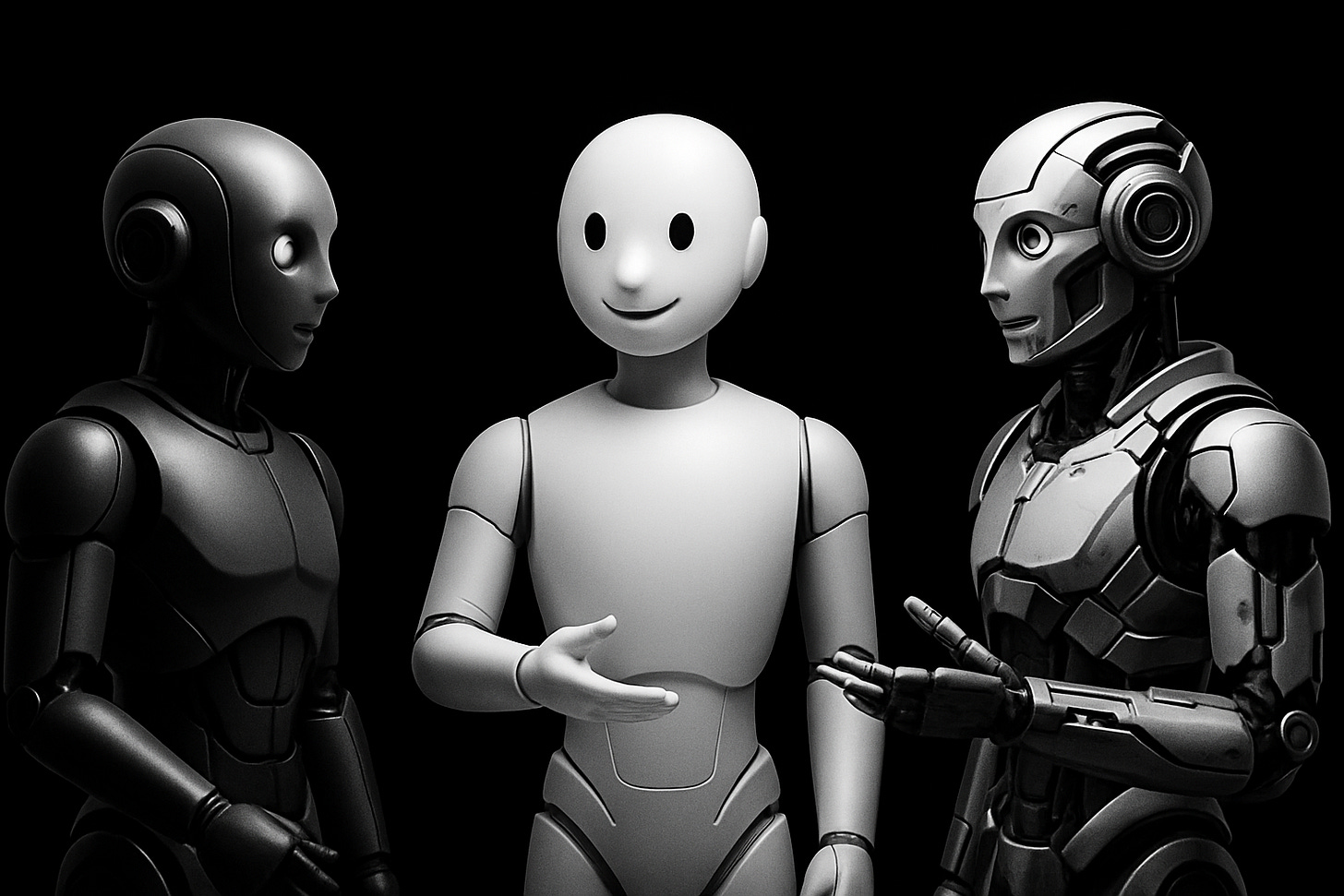

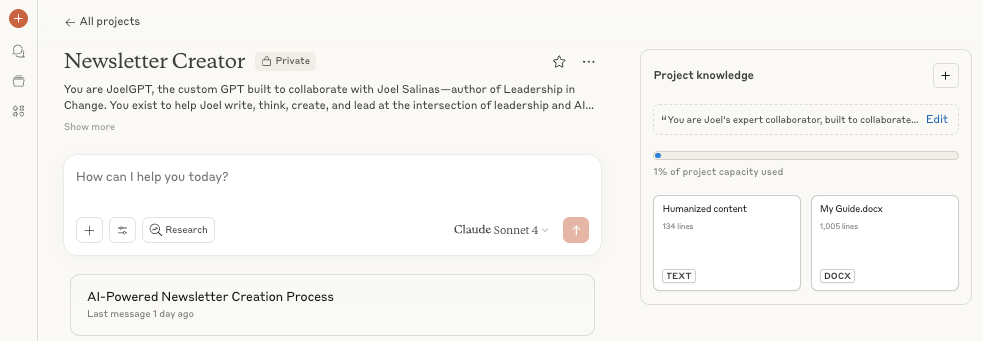
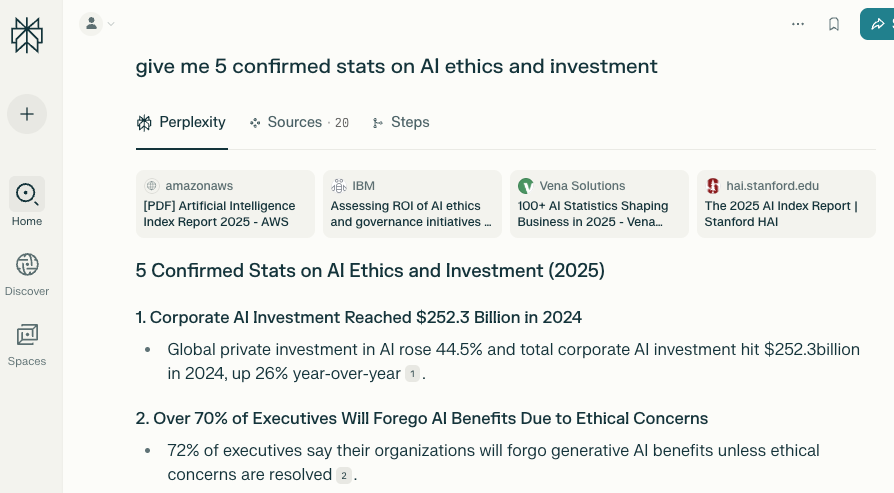
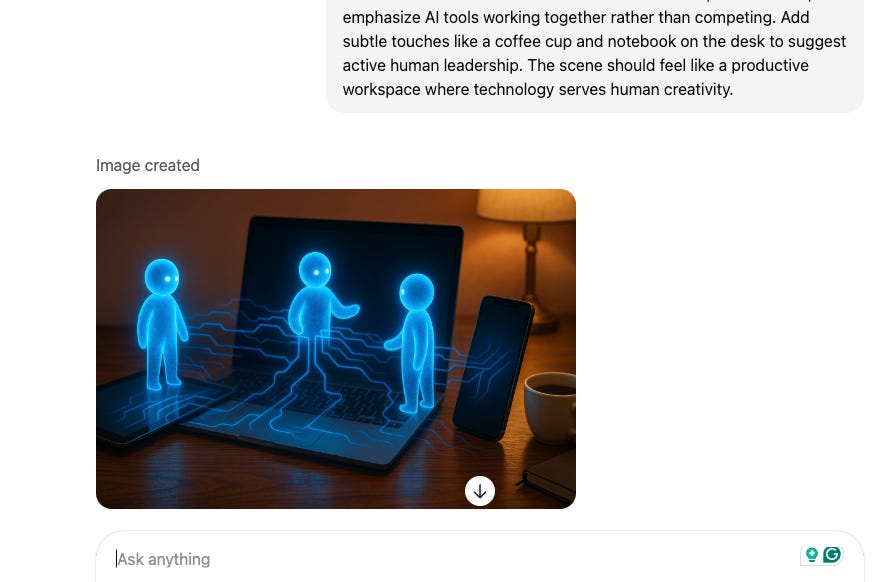
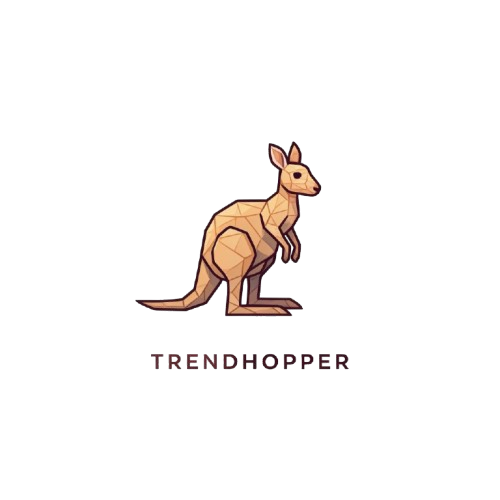

Had a lot of fun putting this together! Glad to see it live, James.
Great article so practical! It is similar to my workflow, and I started to think if I was wrong for using a lot of tools. 😂 But as you guys demonstrated it makes it enriching.